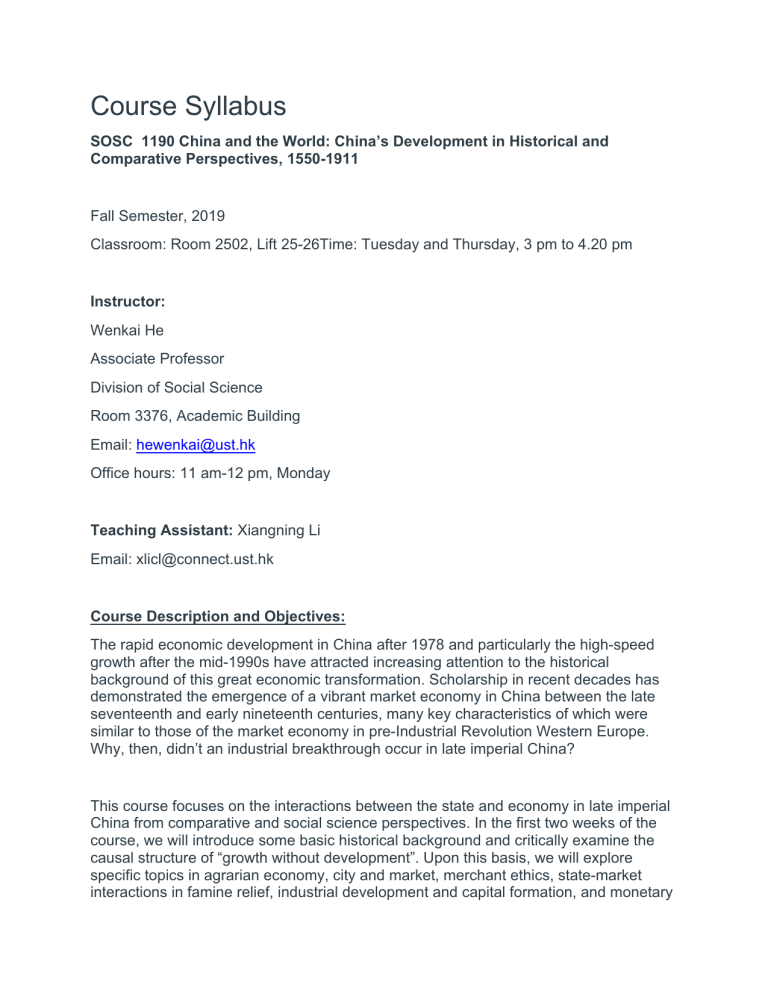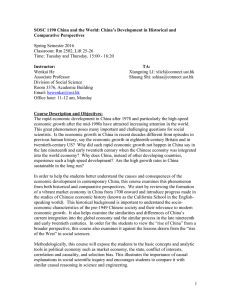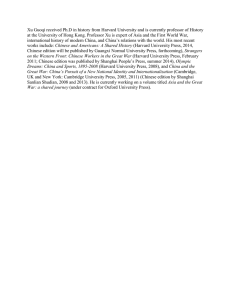
Course Syllabus SOSC 1190 China and the World: China’s Development in Historical and Comparative Perspectives, 1550­1911 Fall Semester, 2019 Classroom: Room 2502, Lift 25­26Time: Tuesday and Thursday, 3 pm to 4.20 pm Instructor: Wenkai He Associate Professor Division of Social Science Room 3376, Academic Building Email: hewenkai@ust.hk Office hours: 11 am­12 pm, Monday Teaching Assistant: Xiangning Li Email: xlicl@connect.ust.hk Course Description and Objectives: The rapid economic development in China after 1978 and particularly the high­speed growth after the mid­1990s have attracted increasing attention to the historical background of this great economic transformation. Scholarship in recent decades has demonstrated the emergence of a vibrant market economy in China between the late seventeenth and early nineteenth centuries, many key characteristics of which were similar to those of the market economy in pre­Industrial Revolution Western Europe. Why, then, didn’t an industrial breakthrough occur in late imperial China? This course focuses on the interactions between the state and economy in late imperial China from comparative and social science perspectives. In the first two weeks of the course, we will introduce some basic historical background and critically examine the causal structure of “growth without development”. Upon this basis, we will explore specific topics in agrarian economy, city and market, merchant ethics, state­market interactions in famine relief, industrial development and capital formation, and monetary system and public finance. Beyond observing parallels between pre­Industrial Revolution Western Europe and late imperial China, we will also examine some of the institutional defects of the Chinese economy (state?) and how they affected the transformation of China into a modern economy in the late nineteenth century. Methodologically, this course will expose students to the basic concepts and analytic tools in political economy such as market economy, the state, conflict of interests, correlation and causality, and selection bias. The aim is to illustrate the importance of causal explanations in social scientific inquiry and encourage students to make comparisons with similar causal reasoning in science and engineering. Requirements: Read the assigned readings before the class and participate in class discussion. Grading: Mid­term exam: 40 percent The mid­term exam will be a closed­book exam. Final Group Project: 60 percent For the final group project, three students will form one group to work on the following topic and collectively submit a term paper; the length of the paper should be 14­16 double­spaced pages. Topic: Suppose that there had been no Sino­Japanese War in 1894­95 and only international trade in a peaceful East Asia after 1895. What kind of changes, if any, do you think would have happened in the Chinese economy in the 30 years after 1895, and why? Your hypothetical scenario should be based upon the indigenous resources for economic development in China and the strengths and weaknesses of the Chinese political economy as of 1895 as discussed in this course. You MUST collect some materials from contemporary newspapers published in China in either English (such as the North China Herald) or in Chinese (Shenbao 申報) and use these in the term paper. This is an open­ended exercise; there is no single “right” answer. Each paper will be evaluated on the group’s ability, as demonstrated in the paper, to lay out the scenario clearly, to argue logically for your conclusion, to utilize concepts introduced in the course, and to marshal relevant and compelling evidence to support your argument from class materials and your own research. Please note that all three students in the group will receive the same grade based upon the quality of the paper. Readings: Week 1: Introduction: The connection of late imperial China to the world Gang Zhao, The Qing Opening to the Ocean: Chinese Maritime Policies, 1684­1757 ( Honolulu: University of Hawai’i, 2013), pp. 116­36. Week 2: Commercial development in China: 1684­1820 Susan Naquin and Evelyn S. Rawski, Chinese Society in the Eighteenth Century (New Haven: Yale University Press, 1987), pp. 138­216. Week 3: Growth without Development? John K. Fairbank and Merle Goldman, China: A New History, enlarged edition ( Cambridge: The Belknap Press of Harvard University Press, 1998), pp. 167­86. Mark Elvin, The Pattern of the Chinese Past (Stanford: Stanford University Press, 1973 ), pp. 298­315. Week 4: The land issue: Cause or effect? Robert C. Allen, The British Industrial Revolution in Global Perspective (Cambridge: Cambridge University Press, 2009), Chapter 3, “The Agricultural Revolution” Philip C.C. Huang, The Peasant Family and Rural Development in the Yangzi Delta, 1350­1988 (Stanford: Stanford University Press, 1990), pp. 44­92. Week 5: Business ethics and development Max Weber, The Protestant Ethic and the Spirit of Capitalism (New York: Charles Scribner’s Sons, 1976), “Author’s Introduction”, pp. 13­27 and Chapter 2 “The Spirit of Capitalism,” pp. 47­78. Richard J. Lufrano, Honorable Merchants: Commerce and Self­Cultivation in Late Imperial China (Honolulu: University of Hawai‘i Press, 1997), pp. 1­98. Week 6: Famine relief in late imperial China: State and Economy Lillian M. Li, Fighting Famine in North China: State, Market, and Environmental Decline, 1690s­1990s (Stanford: Stanford University Press, 2007), Chapter 8, “Famine Relief: The High Qing Model,” pp. 221­49. Pierre­Etienne Will, Bureaucracy and Famine in Eighteen­Century China, translated by Elborg Forster (Stanford: Stanford University Press, 1990), Chapter 12, “The Evolution of the State’s Economic Means,” pp. 289­301. Week 7: A revisionist view of the pre­20th century Chinese economy Madeleine Zelin, The Merchants of Zigong: Industrial Entrepreneurship in Early Modern China (New York: Columbia University Press, 2005), Chapters 1 and 2. Kenneth Pomeranz, The Great Divergence: China, Europe and the Making of the Modern World (Princeton: Princeton University Press, 2000), “Technology?” pp. 43­68. Week 8: Silver in and silver out: Lin Man­houng, China Upside Down: Currency, Society, and Ideologies, 1808­1856 ( Cambridge: The Harvard University of Asia Center of the Harvard University Press, 2006), chapters 1 and 3. Week 9: The deadly good: The opium trade and the Opium War Chen Li, Chinese Law in Imperial Eyes: Sovereignty, Justice, and Transcultural Politics (New York: Columbia University Press, 2016), Chapter 5. Week 10: The Self­Strengthening Movement: 1863­1895 Stephen R. Halsey, Quest for Power: European Imperialism and the Making of Chinese Statecraft (Cambridge, MASS.: Harvard University Press, 2015), either chapter 6 or 7. Benjamin A. Elman, “Naval Warfare and the Refraction of China’s Self­Strengthening Reform into Scientific and Technological Failure, 1865­1895,” Modern Asian Studies, vol. 38, No. 2 (May, 2004): 283­326. Week 11: Civil Society and the Public Sphere in the Chinese Society, 1870­1895 Kathryn Edgerton­Tarpley, Tears from Iron: Cultural Responses to Famine in Nineteenth­Century China (Berkeley: The University of California Press, 2008), pp. 90­ 155. Week 12: The tributary system and the international law: China in East Asia Yuanchong Wang, Remaking the Chinese Empire: Manchu­Korean Relations, 1616­ 1911 (Ithaca: Cornell University Press, 2018), chapter 5 and 6. Week 13: What is China? The legacy of the Qing empire Joseph W. Esherick, “How the Qing Became China,” in Joseph W. Esherick and Hasan Kayalu and Eric Van Young, eds., Empire to Nation: Historical Perspectives on the Making of the Modern World (Rowman & Littlefield Publishers, 2006), pp. 299­259.





